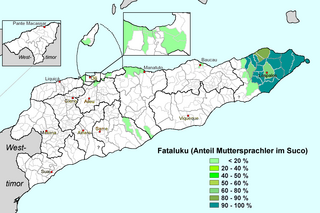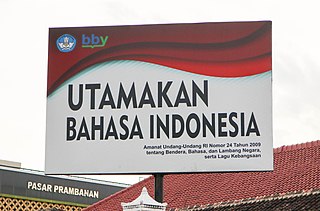Related Research Articles

Malay is an Austronesian language that is an official language of Brunei, Indonesia, Malaysia, and Singapore, and that is also spoken in East Timor and parts of Thailand. Altogether, it is spoken by 290 million people across Maritime Southeast Asia.

Alor is the largest island in the Alor Archipelago and is one of the 92 officially listed outlying islands of Indonesia. It is located at the eastern Lesser Sunda Islands that runs through southeastern Indonesia, which from the west include such islands as Bali, Lombok, Sumbawa, Komodo, and Flores.
In addition to its classical and modern literary form, Malay had various regional dialects established after the rise of the Srivijaya empire in Sumatra, Indonesia. Also, Malay spread through interethnic contact and trade across the south East Asia Archipelago as far as the Philippines. That contact resulted in a lingua franca that was called Bazaar Malay or low Malay and in Malay Melayu Pasar. It is generally believed that Bazaar Malay was a pidgin, influenced by contact among Malay, Hokkien, Portuguese, and Dutch traders.

Fataluku is a Papuan language spoken by approximately 37,000 people of Fataluku ethnicity in the eastern areas of East Timor, especially around Lospalos. It is a member of the Timor-Alor-Pantar language family, which includes languages spoken both in East Timor and nearby regions of Indonesia. Fataluku's closest relative is Oirata, spoken on Kisar island, in the Moluccas of Indonesia. Fataluku is given the status of a national language under the constitution. Speakers of Fataluku normally have a command of Tetum and/or Indonesian, those speakers who are educated under Portuguese rule or from younger generation educated under Portuguese-language educational system during independence speak Portuguese.

Western Pantar, sometimes referred to by the name of one of its dialects, Lamma, is a Papuan language spoken in the western part of Pantar island in the Alor archipelago of Indonesia. Western Pantar is spoken widely in the region by about 10,000 speakers. Although speakers often use Malay in political, religious, and educational contexts, Western Pantar remains the first language of children of the region, and is acquired to some extent by immigrants.
Nedebang is a Papuan language spoken in the villages of Balungada and Baulang in the eastern district of Pantar island in the Alor archipelago of Indonesia. There are also Nedebang speakers in Air Panas, administratively part of Balungada but located 1 km from the main village.

More than 700 living languages are spoken in Indonesia. This figure indicates that Indonesia has about 10% of the world's languages, establishing its reputation as the second most linguistically diverse nation in the world after Papua New Guinea. Most languages belong to the Austronesian language family, while there are over 270 Papuan languages spoken in eastern Indonesia. The language most widely spoken as a native language is Javanese.

The Alor–Pantar languages are a family of clearly related Papuan languages spoken on islands of the Alor archipelago near Timor in southern Indonesia. They may be most closely related to the Papuan languages of eastern Timor, but this is not yet clear. A more distant relationship with the Trans–New Guinea languages of the Bomberai peninsula of Western New Guinea has been proposed based on pronominal evidence, but though often cited has never been firmly established.
Alorese is an Austronesian language spoken on Alor and the neighboring islands of the Alor archipelago in eastern Indonesia. It is not to be confused with non-Austronesian (Papuan) languages of the Alor–Pantar family which are also spoken in this region. It is also distinct from Alor Malay, a Malay variety which is currently supplanting Alorese as the language of wider communication in the region. Alorese is the native language of several immigrant communities located along the coast of the Alor Archipelago, especially at Alor Kecil and Kalabahi in Alor, and at Baranusa and Marisa in Pantar. It has also been used extensively as a trade language in the region. One of the varieties is Dulolong.
Papuan Malay or Irian Malay is a Malay-based creole language spoken in the Indonesian part of New Guinea. It emerged as a contact language among tribes in Indonesian New Guinea for trading and daily communication. Nowadays, it has a growing number of native speakers. More recently, the vernacular of Indonesian Papuans has been influenced by Standard Indonesian, the national standard dialect. It is spoken in Indonesian New Guinea alongside 274 other languages and functions as a lingua franca.
Kui is a Timor–Alor–Pantar language spoken in several enclaves on Alor Island, East Nusa Tenggara, Indonesia. The language is called 'Masin lak' in Kui. Although the exact number of speakers is unknown, Kui is an endangered language since speakers are shifting to Alor Malay.

The Wersing language, also known as Kolana after its primary dialect, is spoken in scattered settlements around the coast of Alor in Indonesia. Due to this settlement pattern, Wersing speakers are in contact with Abui and Kamang speakers and often have some competence in these languages. Though not closely related, it has cultural connections with Tukudede on the neighboring island of Timor.
Dusner is a language spoken in the village of Dusner in the province of West Papua, Indonesia. Dusner is highly endangered, and has been reported to have just three remaining speakers.
Tambora is a (Papuan) and included in branch West Papuan spoken by the Tamboran people of central Sumbawa, in what is now Indonesia, that was made extinct by the 1815 eruption of Mount Tambora. It was the westernmost known Papuan language and was relatively unusual among such languages in being the language of a maritime trading state, though contemporary Papuan trading states were also found off Halmahera in Ternate and Tidore.
Sawila, or Tanglapui, is a Papuan language of the Alor archipelago. Dialects are Sawila proper, Lona, Salimana, Lalamana, Sileba. Sawila speakers refer to their language as Manata.

Blagar is a Papuan language of Pantar island in the Alor archipelago of Indonesia. The Tereweng dialect spoken on Tereweng Island off the southeast coast of Pantar is sometimes considered a separate language.
Woisika, also known as Kamang, is a Papuan language of Alor Island of Indonesia. The three main dialects are Western Kamang, Lowland Kamang, and Upland Kamang. Dialects also include Lembur, Sibo, Kamang, Tiayai, Watang, Kamana-Kamang. They may constitute more than one language. Kamang is an endangered language, since children usually only have passive competence of the language, and instead are shifting to Malay.
Lamaholot, also known as Solor or Solorese, is a Central Malayo-Polynesian dialect cluster of Flores, Indonesia. The varieties may not be all mutually intelligible; Keraf (1978) reports that there are 18 languages under the name.
The Afoa language may refer to:

The Abui are an indigenous ethnic group residing on Alor Island, East Nusa Tenggara, Indonesia. Abui people are spread across the districts of South Alor, East Alor, and Northwest Alor in Alor Regency. Abui people speak the Abui language, which is a Papuan (non-Austronesian) language, as well as Indonesian, and a Malay-based creole known as Alor Malay.
References
- ↑ "UNESCO Atlas of the World's Languages in danger". www.unesco.org. Retrieved 2018-06-06.
- 1 2 3 Baird, Louise (2017). "Kafoa". In Schapper, Antoinette (ed.). The Papuan Languages of Timor, Alor and Pantar: Volume 2. Walter de Gruyter. pp. 55–108.
- ↑ Kafoa at Ethnologue (27th ed., 2024)
